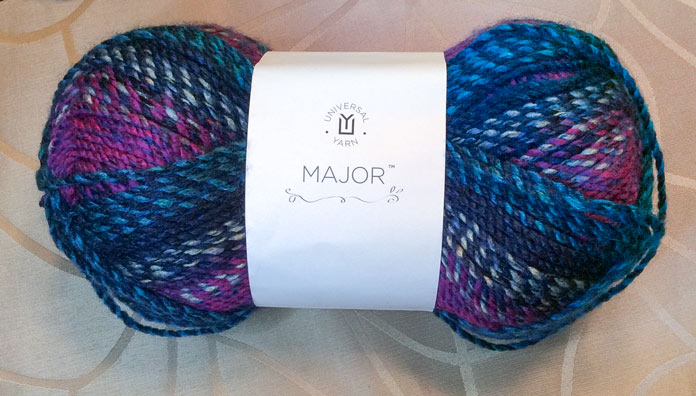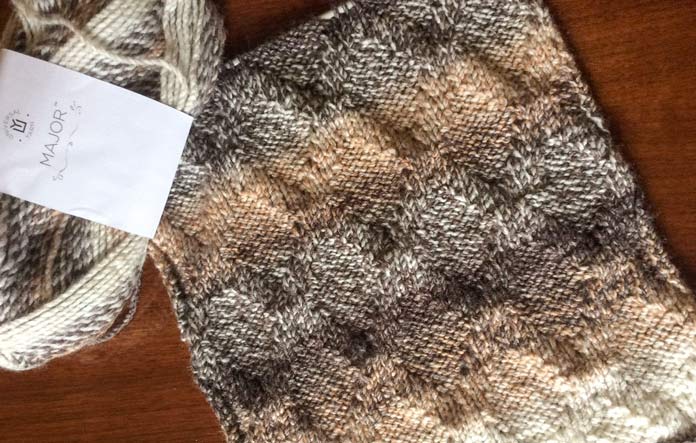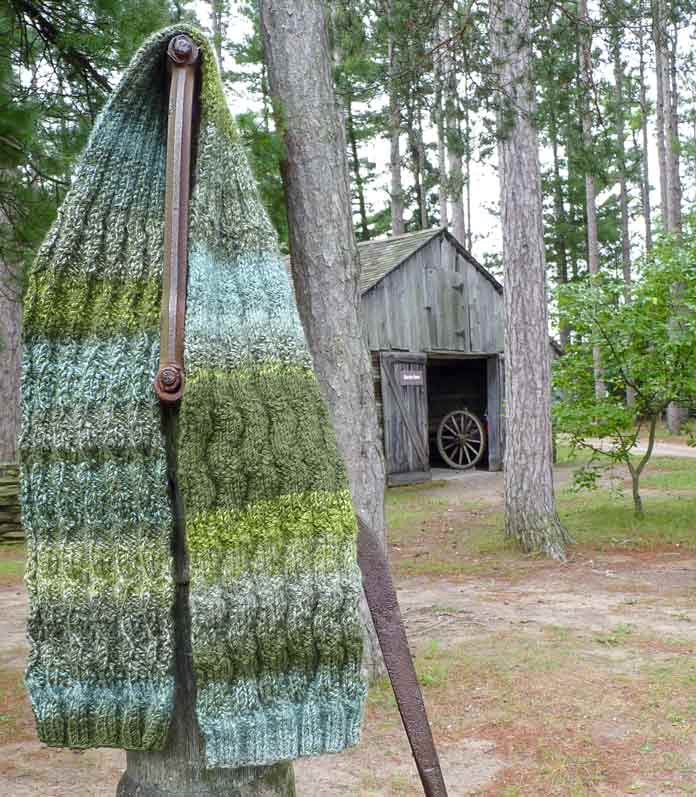I’ve been reviewing Major yarn in this series of posts. Major is a bulky, 100% acrylic yarn that is soft enough for next-to-skin wear and quick enough to knit that you can make a scarf in a weekend!
On Tuesday, I had an idea for a baby blanket using the Honeydew colorway. I gave the pattern in Wednesday’s post. That was a bonus pattern, as I had intended this week’s project to be a hat and scarf set for myself in the Stonewall colorway.
Well, inspiration struck again, and the Verdant colorway inspired a seafarer’s style scarf! Yesterday, I explained the ingenious construction of these useful accessories.

One of our samples was made in the Firecracker colorway of Major.
I’ll also sample scarf patterns using the other colorways I’ve been enjoying this week.
I considered two chevron patterns – the Chevron and Pinnacle Chevron from Barbara G. Walker’s first book, A Treasury of Knitting Patterns, but I’ve been on a bit of a chevron kick lately and I don’t want my kick to become a full-on rut.

The Firecracker colorway worked in a garter stitch zigzag. This pattern would make an attractive panel on a seafarer’s scarf.
Then, I considered using Imitation Lattice or widening the Garter Stitch Zigzag, also from the first Treasury. However, when perusing Ms. Walker’s second Treasury, I came across an old favorite, Seaweed. This pattern has a different, yet attractive look on either side, and, given the color we’re working with (Verdant), I couldn’t resist revisiting my old friend.
I had originally planned to do a scarf using Stonewall, as it’s a good match for my winter coat, and, having created the swatch in the photo above, I plan to use the Imitation Lattice pattern for it.

Imitation Lattice in the Stonewall colorway. This knit-purl pattern looks attractive on the reverse side as well. This will become a scarf to complement my winter coat.
To make our seaweed seafarer’s scarf, I’ve chosen the “top-down” construction method, which, briefly put, is made by casting on the stitches using a provisional cast on, knitting the ribbing section, then picking up the stitches from the provisional cast on and working both end panels top-to-bottom at the same time. For further details, refer back to the yesterday’s post.

The verdant colorway in a verdant setting. The neckband of the scarf has been twisted to show both sides of the Seaweed pattern. The panel on the left looks like seaweed flowing under water!
Seaweed Seafarer’s Scarf
materials
1 skein Major, 100% acrylic, bulky yarn
US size 9 [5.5mm] needles
US size 10 [6mm] needles
tapestry needle
gauge
36 sts over 4″ [10cm] over 3 x 3 ribbing
Neckband
Using a provisional cast on and size 9 [5.5mm] needles, cast on 36 sts.
Row 1: *K3, p3; rep from * to end.
Repeat Row 1 until work measures 15″ [38cm] or desired length.

Panels (work both at the same time)
Knit across stitches, then join in another strand of yarn and knit across the stitches from the provisional cast on. (See diagram for direction of knitting.)
Work both panels at the same time.
Row 1: *P4, k2; rep from * across.
Row 2 and all even numbered rows: K all k sts and p all p sts.
Row 3: *P3, k3; rep from * across.
Row 5: *P2, k4; rep from * across.
Row 7: P1, *k4, p2; rep from * to last 5 sts, k4, p1.
Row 9: P1, *k3, p3; rep from * to last 5 sts, k3, p2.
Row 11: P1, *k2, p4; rep from * to last 5 sts, k2, p3.
Row 12: As Row 2.
Repeat these 12 rows until each panel measures 24″ [60cm] or desired length. End with a Row 3. Repeat Rows 2 and 3 three more times. Cast off all sts, and weave in all ends.

A closer look at the front panels of the Seafoam Seafarer’s Scarf
This has been a very fun week for me. I hope you’ve enjoyed it as well.
Major has a lot of attributes – it’s quick-to-knit, it washes easily, it’s comfortable to wear next to the skin, it has many colorways, and it looks great! Ask for it at your local yarn shop, and enjoy some of the patterns I’ve provided for you this week.
This is part 5 of 5 in this series.
Go back to part 4: Seafarer’s scarf construction tips and Major yarn
[shareaholic app=”follow_buttons” id=”23784471″]
